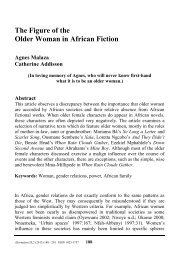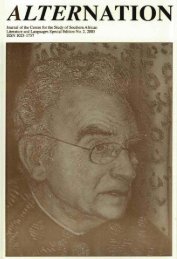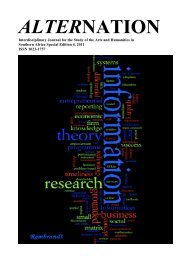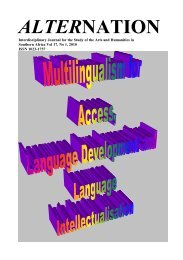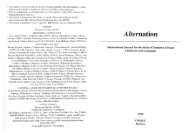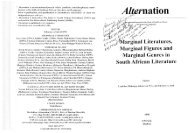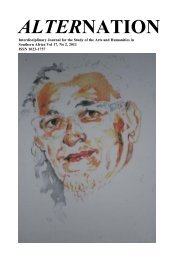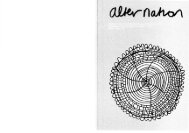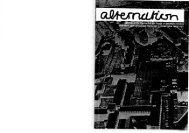Re-reading The Purloined Letter - Alternation Journal
Re-reading The Purloined Letter - Alternation Journal
Re-reading The Purloined Letter - Alternation Journal
You also want an ePaper? Increase the reach of your titles
YUMPU automatically turns print PDFs into web optimized ePapers that Google loves.
383<br />
<strong>Re</strong>-<strong>reading</strong> <strong>The</strong> <strong>Purloined</strong> <strong>Letter</strong><br />
mirror or not, still the moment is psychologically a visualization of the self<br />
as a whole. How do these questions of looking and identity manifest<br />
themselves in the seminar on <strong>The</strong> <strong>Purloined</strong> <strong>Letter</strong>?<br />
Lacan sees a strong dynamic of power exchanged between the<br />
seeing and the blindness operating in Poe’s story. Concealment of the lost,<br />
guilty object is ensured not by making the thing itself invisible (hiding the<br />
letter in a secret draw, or under the floorboards) but by understanding that<br />
‘concealment’ can be ensured on quite different conditions: the story is<br />
‘about an observer being observed without observing that she is being<br />
watched in turn’ (Muller & Richardson <strong>The</strong> <strong>Purloined</strong> Poe, pvii). Both acts<br />
of purloining the letter rely upon an understanding that the subject is blind in<br />
certain situations, even though he or she can technically see—what Freud<br />
(1896:181) was to call in Studies of Hysteria ‘that blindness of the seeing<br />
eye’. For Williams (1995:73) what Lacan refers to as the story’s ‘primal<br />
scene’—its establishing moment—is like all primal scenes in classic<br />
psychoanalysis, predicated upon a dynamic of seeing and of unseeing—<br />
another key visual experience in the formation of the subject, which finds its<br />
way into Lacan’s theory of gender alongside the mirror phase. From this<br />
scene of the story, the letter passes on the first stage of its journey. <strong>The</strong><br />
Queen places on display, as if to conceal it, the guilty object which threatens<br />
the law, the position of the King. <strong>The</strong> three characters here—King, Queen<br />
and Minister—cannot be decoded as the father/mother/child of the Freudian<br />
tryptich, for Lacan the visual power and anxieties of the primal scene are<br />
nevertheless present. But more than this, the story is a web of exchanged<br />
glances. People see each other’s actions, and see that they are being seen, the<br />
primary element in Lacan’s theory of the gaze, which is always rooted in<br />
what is at stake in being observed ‘we are beings who are always looked at,<br />
in the spectacle of the world’, writes Lacan (1981:75). <strong>The</strong> relation of the<br />
subject with the domain of vision is to be a screen, receiving the Other’s<br />
gaze but lacking its plenitude, not the reverse. For Lacan, then, the subject<br />
does not possess the gaze, but is primarily constituted by it. This supremely<br />
paranoid concept is an important element of the child’s growing experience<br />
of the world as Other, in its entry in the Symbolic. Indeed, this is already a<br />
component of the child’s experience of its gestalt image in the mirror phase,<br />
for although this was primarily a narcissistic experience (in which the child<br />
saw an image of itself in the mirror), it is also the first moment at which the



